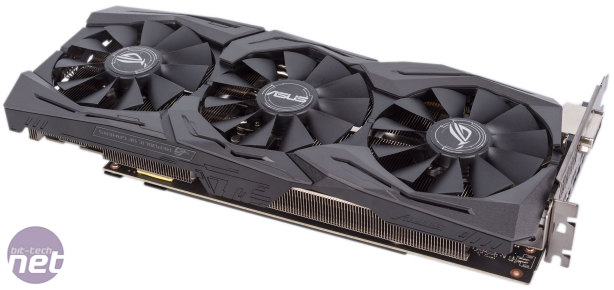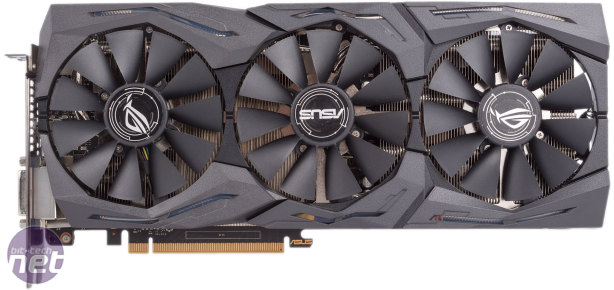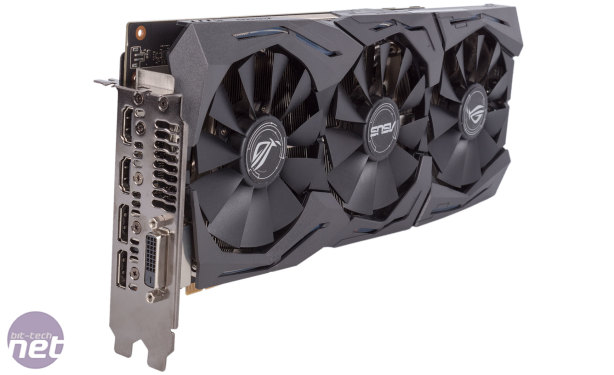Performance Analysis
Looking at average frame rates, the GTX 1060 Strix OC's additional clock speed gives it a six percent lead on average over the regular Founders Edition, and this is the sort of gain you can expect over other cards using reference clock speeds as well. AMD's closest current generation competitor is the RX 480 8GB, which the Asus card is able to better by eight percent on average. As for older generation cards, this card is practically the same as a reference GTX 980 (well, it's 1 percent better overall) but loses to the Radeon R9 390X by 4 percent.The card offers rock solid, console-smashing performance at 1080p, never dipping into unplayable territory even in the most demanding situations, and with minimums often above 60fps you can be sure of silky smooth, high detail gaming. At 1440p, the card is typically in the 30-60fps range (ripe for G-Sync), but we do see its minimum dip to 23fps in The Division, our hardest benchmark to get through, so you may have to drop from ultra to high settings here and there.
As we've seen before, Nvidia's DirectX 12 performance is a little worse relative to AMD compared to its DX11 showing. In our games, for example, this card is 13.5 percent faster than the reference RX 480 8GB in DX11, but in DX12 AMD completely makes up the difference – there's no difference in average frame rate in Total War: Warhammer, for example, and AMD's card is actually faster in Hitman. Of course, this is something relevant to all partner GTX 1060s, not just this Asus model, but it's worth bearing in mind nonetheless.
The higher clocks and triple-fan cooler see power consumption increase by around 20W over the Founders Edition card, or a little less in Gaming and Silent Modes. In the fastest state, OC Mode, the card was running at a constant 2,025MHz, dropping to 2,000MHz in Gaming Mode and 1,974MHz in Silent Mode. The Unigine Valley 1440p results show just how little difference there is in terms of performance between the various modes.
Even on a relatively hot day, the GTX 1060 Strix OC's core barely crept above 60°C, and the resultant delta T is the current lowest for an air-cooled card we've seen – that's what you get when you pair a monster cooler with an already very efficient GPU. The fans reached 46 percent speed, or roughly 1,700 RPM, to achieve this, and the temperature and fan speed remained unaltered in Gaming and Silent Modes – as we said, you may as well just stick to OC Mode and forget about it.
One small concern is that this fan speed is actually higher than we saw on the GTX 1070 Strix OC, which uses the same cooler and only reached 1,400 RPM. Admittedly, the temperature here is slightly lower, and the difference in noise isn't a lot – this is still a very quiet card when under load. However, we shouldn't be seeing higher fan speeds from the same cooler on the a lower TDP part. Perhaps the cooler is just a bit less effective by dint of its heat pipes not being able to make as much contact with the smaller GPU; maybe a contact plate to spread the heat transfer would be more effective here.
Overclocking allowed us to squeeze typically an extra 7 percent of performance or so from the GTX 1060 Strix OC. In this state, the card was completely happy boosting to a sustained 2,100MHz, which is the fastest we've seen from a Pascal GPU thus far. System power consumption went up to 308W, and the fans and temperature each crept up a little too. While it is faster than an overclocked GTX 1060 Founders Edition and an overclocked AMD Radeon RX 480 8GB, the real-world difference in games between the three is very slim – unnoticeable, in fact.
Conclusion
Priced the wrong side of £300, Asus was always going to have to do a lot to impress us with this card. In fairness, there isn't much that the GTX 1060 Strix OC doesn't offer – it has a very high factory overclock applied to the core and the memory has been boosted slightly too. The VR-friendly display outputs are a neat idea, as is the pair of 4-pin fan headers. The card has access to more juice with its 8-pin power input as well as upgraded power circuitry components and our sample at least proved to be a solid overclocker. Build quality is very high and you get RGB lighting thrown into the mix, and the cooler has no issue keeping the GTX 1060 cool and quiet, although we can't help but think the cooler was designed more with the GTX 1070 and GTX 1080 in mind; the slightly higher fan speed we saw here compared to with the GTX 1070 Strix OC is unfortunate, but there's at least loads of headroom to limit the fan speed here even more if noise becomes at all a concern, which we'd say is unlikely. We also look forward to seeing a more unified software approach from Asus.Clearly, Asus can't be accused of skimping on features or performance here as it's thrown practically everything it's got at the GTX 1060 to produce this card. Paying a little extra for such niceties is common practice in the GPU market, hence the wide range partner cards covering various price points. However, we're not convinced Asus's strategy here is the right one for this card. The GTX 1060 may not be as price-focussed as the GTX 960 was, but it's still a price-sensitive GPU. As such, in spite of all the positives, the near £100 markup on standard GTX 1060s is just too much for us to be able to recommend this card. If you truly want the best the GTX 1060 has to offer, then this is likely it. However, by the time you get to the £325 Asus is asking for here, there's a solid case for just saving for a custom-cooled GTX 1070, which can be had for £360 at the time of writing and will offer plenty more grunt even at stock speeds.


MSI MPG Velox 100R Chassis Review
October 14 2021 | 15:04












Want to comment? Please log in.